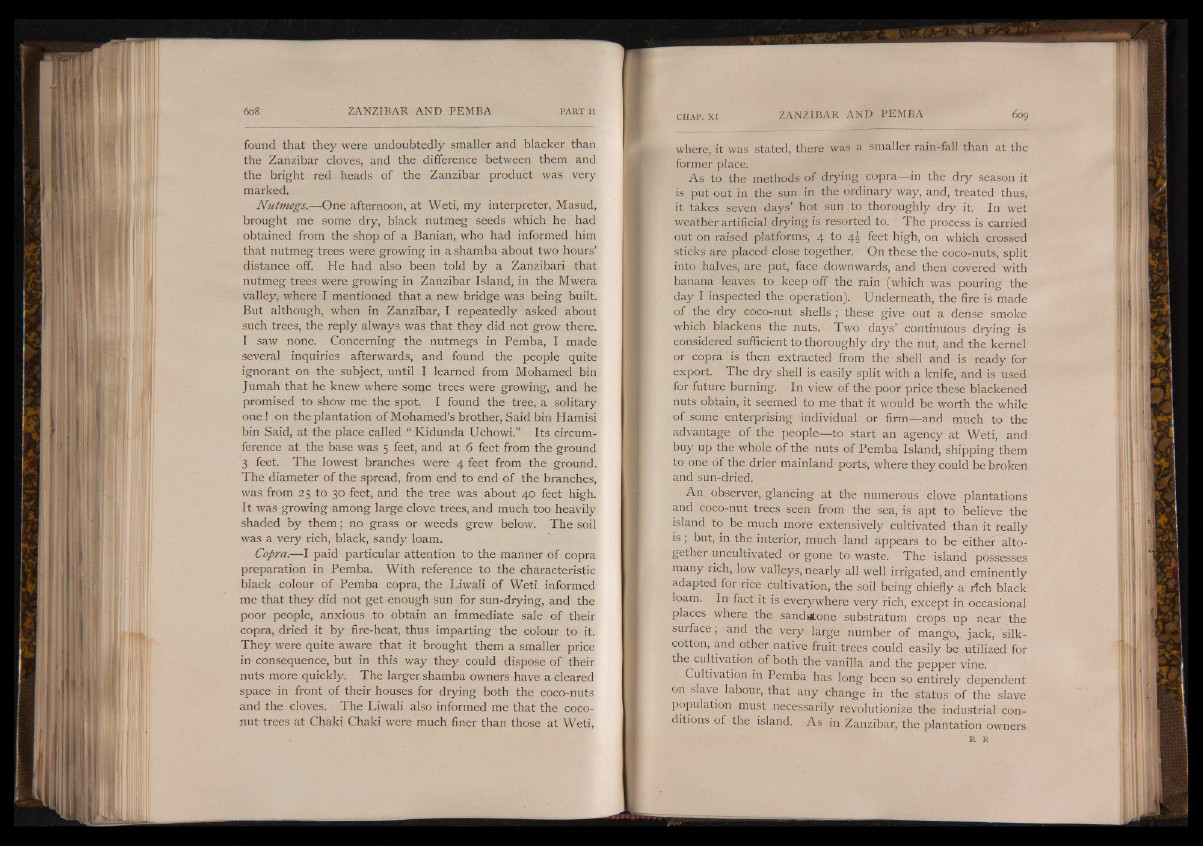
found that they were undoubtedly smaller and blacker than
the Zanzibar cloves, and the difference between them and
the bright red heads of the Zanzibar product was very
marked.
Nutmegs..— One afternoon, at Weti, my interpreter, Masud,
brought me some dry, black nutmeg seeds which he had
obtained from the shop of a Banian, who had informed him
that nutmeg trees were growing in a shamba about two hours’
distance off. He had also been told by a Zanzibari that
nutmeg trees were growing in Zanzibar Island, in the Mwera
valley, where I mentioned that a new bridge was being built.
But although, when in Zanzibar, I repeatedly asked about
such trees, the reply always was that they did not grow there.
I saw none. Concerning the nutmegs in Pemba, I made
several inquiries afterwards, and found the people quite
ignorant on the subject, until I learned from Mohamed bin
Jumah that he knew where some trees were growing, and he
promised to show me the spot. I found the tree, a solitary
one! on the plantation of Mohamed’s brother, Said bin Hamisi
bin Said, at the place called " Kidunda Uchowi.” Its circumference
at the base was 5 feet, and at 6 feet from the ground
3 feet. The lowest branches were 4 feet from the ground.
The diameter of the spread, from end to end of the branches,
was from 25 to 30 feet, and the tree was about 40 feet high.
It was growing among large clove trees, and much too heavily
shaded by them; no grass or weeds grew below. The soil
was a very rich, black, sandy loam.
Copra.— I paid particular attention to the manner of copra
preparation in Pemba. With reference to the characteristic
black colour of Pemba copra, the Liwali of Weti informed
me that they did not get enough sun for sun-drying, and the
poor people, anxious to obtain an immediate sale of their
copra, dried it by fire-heat, thus imparting the colour to it.
They were quite aware that it brought them a smaller price
in consequence, but in this way they could dispose of their
nuts more quickly. The larger shamba owners have a cleared
space in front of their houses for drying both the coco-nuts
and the cloves. The Liwali also informed me that the coconut
trees at Chaki Chaki were much finer than those at Weti,
where, it was stated, there was a smaller rain-fall than at the
former place.
As to the methods of drying copra— in the dry season it
is put out in the sun in the ordinary way, and, treated thus,
it takes seven days’ hot sun to thoroughly dry it. In wet
weather artificial drying is resorted to. The process is carried
out on raised platforms, 4 to 41 feet high, on which crossed
sticks are placed close together. On these the coco-nuts, split
into halves, are put, face downwards, and then covered with
banana leaves to keep off the rain (which was pouring the
day I inspected the operation). Underneath, the fire is made
of the dry coco-nut shells; these give out'a dense smoke
which blackens the nuts. Two days’ continuous drying is
considered sufficient to thoroughly dry the nut, and the kernel
or copra is then extracted from the shell and is ready for
export. The dry shell is easily split with a knife, and is used
for future burning. In view of the poor price these blackened
nuts obtain, it seemed to me that it would be worth the while
of some enterprising individual or firm— and much to the
advantage of the people— to start an agency at Weti, and
buy up the whole of the nuts of Pemba Island, shipping them
to one of the drier mainland ports, where they could be broken
and sun-dried.
An observer, glancing at the numerous clove plantations
and coco-nut trees seen from the sea, is apt to believe the
island to be much more extensively cultivated than it really
is; but, in the interior, much land appears to be either altogether
uncultivated or gone to waste. The island possesses
many rich, low valleys, nearly all well irrigated, and eminently
adapted for rice cultivation, the soil being chiefly a- rich black
loam. In fact it is everywhere very rich, except in occasional
places where the sandatone substratum crops up near the
surface; and the very large number of mango, jack, silk-
cotton, and other native fruit trees could easily be utilized for
the cultivation of both the vanilla and the pepper vine.
Cultivation in Pemba has long been so entirely dependent
on slave labour, that any change in the status of the slave
population must necessarily revolutionize the industrial conditions
of the island. As in Zanzibar, the plantation owners
R R